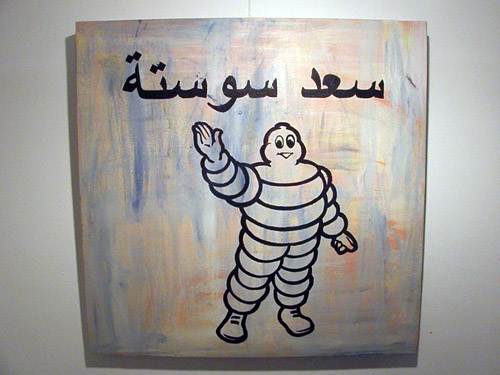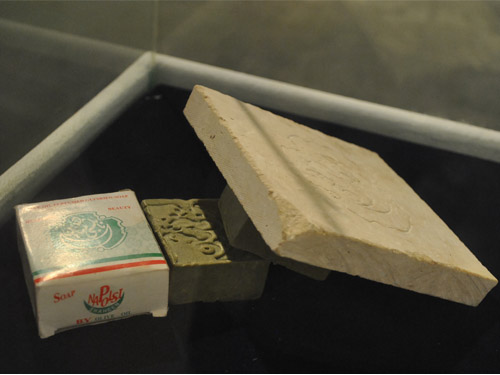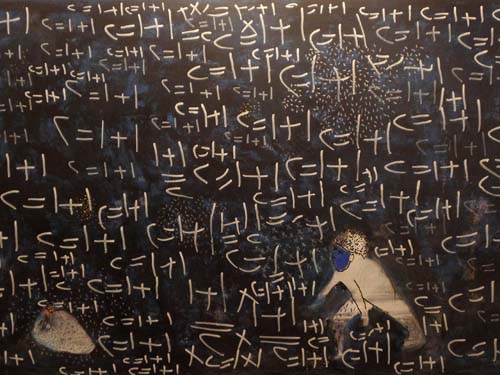
When asked what role art should play in society and culture, Ramy Dozy quickly replies: “To reach a point where that question can be properly answered by the surrounding environment, rather than by artists, who really don’t know anything.” His response is followed by a familiar, playful grin that one soon comes to associate with the majority of Dozy’s statements.
At 29 years of age, Dozy is one of many young Egyptians who have long opted to devote their life exclusively and completely to the creation of art.
“I knew I wanted to be an artist when I was five or six years old. I would steal my Mom’s lipstick and eyeliner, because it’s all I could get my hands on, and draw my heart out, all over the house,” says Dozy with a similar, self-content grin.
“It used to drive them crazy, and I loved that, too,” he laughs.
Two decades later, he is holding his second solo exhibition “Vanilla Eye Candy” at the Gezira Art Center in Zamalek. Through a selection of largely Pop art pieces that feature familiar logos from around the country, Dozy twists their traditional meaning by adding Egyptian colloquial phrases and images, turning them into funny, reflective collages.
For example, the world renowned Michelin Man logo has “Saad Sosta” (“Suspension Saad”) written above it. Dozy explains that it was the nickname — following the local tradition of calling a man after his trade — of a mechanic who worked on his street as a kid. Surely not the association the Michelin brothers were envisioning when they built their first rubber tire in France in the late 19th century, but one that has much more local significance.
Another work shows Karima Mokhtar’s name written underneath the logo of a pharmaceutical powder often given to kids suffering from dehydration. Ironically, Mokhtar is a renowned actress who was part of a campaign in the early 90s that advocated against Egyptian families having too many kids, stressing on the idea that poverty and scarcity will mean that there won't be enough "juice and nutrition" for children.
Overall, Dozy’s latest exhibit is peculiar, funny and insightful — much like Dozy himself — as the pieces often contain a lot of insight with regards to Egyptian commercial culture. His work brings to mind the work of pop artist Andy Warhol, but executed within the context of Egypt, and in a more postmodern fashion, as it actively toys with the objectivity of iconicity.
However, to better understand Dozy, it's important to put aside his latest public exhibit [where pieces are on sale for thousands of pounds] to look at where he comes from, and how he lives his life: in true bohemian fashion.
At the moment, Dozy lives on a rooftop just off of 26th of July Street in Zamalek. It is his living room and workspace, and a small painted shed makes up his print studio and bedroom. There’s little else there, domestically speaking, but some clothes, a kettle to make tea, and some dates.
“It’s the first time I’ve ever lived in Zamalek. It’s perfect,” says Dozy.
However, domestics aside, Dozy’s living domain consists of a vast collection of works, both large and small, as well as thousands upon thousands of sketches, paintings and commercial cuttings — in folders and all over the walls — that he has saved since he was only a toddler.
Dozy, who is originally from Minya, has been making art ever since he could remember. While shuffling through his work, I stumbled upon a school drawing from 1992, when Dozy was only nine years old. It features a portrait of a young man smoking a hash joint proclaiming, “No More Mubarak!”
“I used to get in trouble for things like this, but it seems people eventually agreed with me,” he says, grinning once again. But, despite the current significance of this picture, Dozy admits that he has never been interested in politics, and that the picture is also quite surprising to him, too.
After graduating from school in 2001, he came to study art at the Academy of Arts in Cairo, where he began living his semi-nomadic existence. Dozy has lived in a different suburb almost every year since — Bulaq, Ard al-Lewa, Nozha al-Gedida, and Sayeda Zeinab, to name a few — while creating a large body of work in the process.
“I don’t get inspired from other works of art, I get inspired by Egypt, its streets and culture,” he says. Though judging from his work, the "culture" he refers to is not necessarily traditional Egyptian culture, but Egyptian pop culture.
“This is what Egyptians obsess over, this is our culture,” he laughs, as he shows me his collection of misspelled Diesel Jeans logos, cars with Mercedes stickers, and a commercial for laundry pegs that says “Mahmoud & Nesreen” with a picture of the company owner’s kids. “Who the hell are they and what do they have to do with laundry pegs?” he laughs again.
“You don’t need to do so much to create art in Egypt, you just need to take snapshots; the bizarreness of it should give you plenty to think about and reflect on in terms of culture,” he adds.
Dozy’s obsession with commercial art has often helped him to survive financially over the years, as he did freelance graphic design work for cash when times were tough.
When asked about the struggles of being a young artist in Egypt, Dozy replies that “being an artist anywhere is hard, but in Egypt it is especially hard. Most parents don’t even really understand what their kid is doing,” he laughs.
Despite Dozy’s prolific output, his work never really caught the public eye until mid-2011, when he published pictures online of historic Cairean statues depicted largely out of context, and sometimes disfigured. For example, Naguib Mahfouz’s statue is seen tightrope walking the railing of a bridge, and the Nahdet Mahrousa statue is found in the back of a pickup truck.
“I wanted to disfigure the Egyptian tendency to overly glorify nostalgia,” he says. “The past is like a drug, it can be meaningful in small doses, but too much of it will destroy [a whole culture].”
The French Cultural Center soon offered Dozy a nice sum of money to put on a photo exhibition at their Saad Zaghoul premises at the beginning of this year. Dozy then used the money to put on his current exhibit at the Gezira Center.
On the flyer of the Gezira exhibit, titled “Vanilla Eye Candy: Candy How?" Dozy presents himself as Ramy Dozy — Male Muslim Single, just like it says on his national ID.
“It appears to be all that’s important with regard to who you are in Egypt,” he says with a big grin.
In this sense, a lot of Dozy’s work seems to heavily employ the idea of art serving as a cultural and societal mirror. However, the mirrors he builds are, albeit rooted in pop culture, extensively conceptual, detailed and often insightful.
At his studio, there are hundreds of “mind maps,” where Dozy will stick an image — from the thousands he’s collected since he was a child — or an idea in the center of a piece of paper, and spend days, weeks or years building a web of associations and ideas around it.
“I want to make a subconscious map of everything I have ever seen or heard since I was a child,” he says, adding that the way he creates his work is very stream of conscious, and isn’t only designed for an audience, but also for Dozy to learn from himself.
But while Dozy has so far only put on two full solo exhibitions, he appears to have many ideas in the works for the not too distant future.
His next exhibit, which he is currently working on, is a very extensive kitsch art display that features ads, commercials, brands, phrases and billboard images that he has collected since he was a child.
Leaving his Zamalek rooftop, we duck through some female clothing, presumably belonging to the bawab’s wife, “These aren’t mine, I hope,” he laughs, as he waves goodbye with that ever-present grin.






